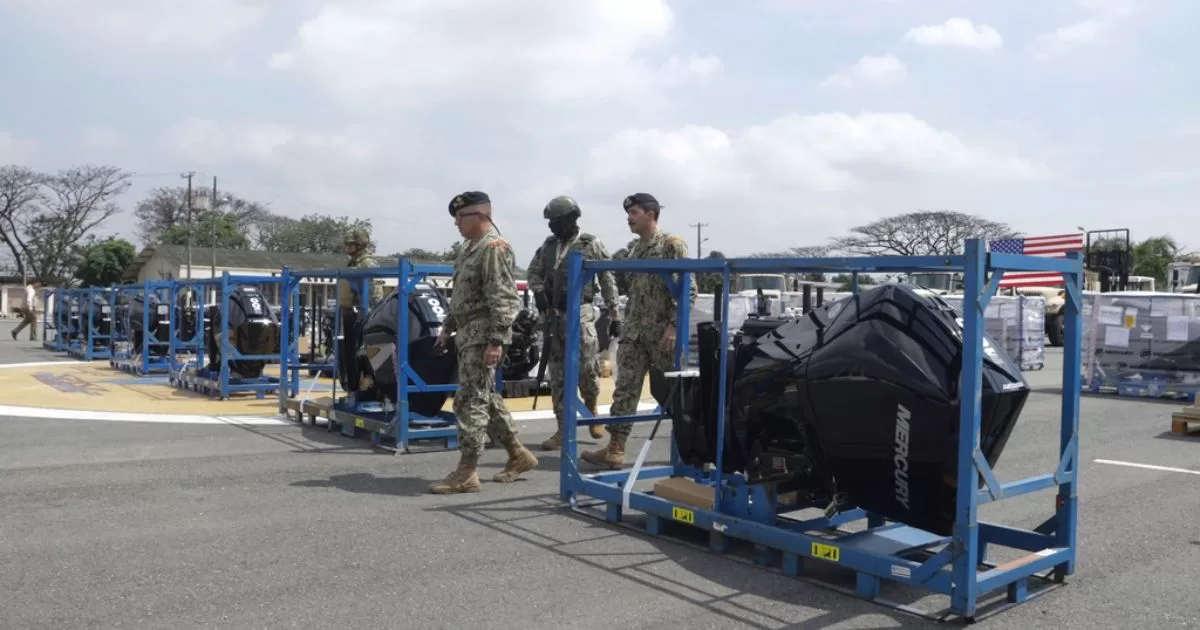A high-level US mission is in Ecuador, where it has held meetings with the president Daniel Noboa, ministers of the security and defense area and military and police chiefs. It is headed by the presidential advisor for the Americas, Christopher Dodd.
In an event with the commander of the US Southern Joint CommandLaura Richardson, the Ecuadorian authorities received the donation of technological and security equipment for the military, which includes six trucks for logistics and transportation, 44 engines for boats, operating systems for boats, ambulances, forklifts and others.
In addition, it is planned that there will be training for Ecuadorians on its operation.
“This is testimony to the joint collaboration (…) of our alliance,” said Richardson, at an event held at a military facility in Guayaquil, where he highlighted that in this way “we will be able to combat transnational criminal organizations that affect both parties.” .
In front of the Ecuadorian military, the US commander assured that it is “an honor” to work hand in hand “to strengthen the same team, the team of democracy.”
The head of Ecuador’s joint command, Admiral Jaime Vela, responded that the armed forces and Ecuador “are grateful, at the same time that we commit to continue developing the capabilities of our armed institution” for the benefit of the country and its inhabitants. He assured that “this military equipment will be used to achieve peace.”
Part of the donation was also delivered to the Risk Management Secretariat, while the rest of the US material will be distributed to other military units in the country.
Cocaine destruction
Earlier, the Ecuadorian government was carrying out the process of destroying nearly 22 tons of cocaine, the largest seizure made in the country, while a state of internal war declared by the government to combat growing crime.
Videos show a truck surrounded by a strong contingent of soldiers with long weapons and then a group of people unloading the packages with drugs dressed in protective suits, glasses and masks. The site of the destruction is being kept confidential for security reasons.
The Ministry of the Interior reported in its X account that in compliance with a court order and using the encapsulation technique it will proceed to destroy the drugs and indicated that the process will take about 11 hours. It was not specified which criminal group the shipment belonged to.
After verifying the weight and type of substance -cocaine hydrochloride-, the crushing of the material and mixture that hardens for its destruction continued, the Director of Police Anti-Narcotics, General William Villaroel, explained to the media.
The anti-narcotics chief explained that the pool where the drug is encapsulated “has lasted for seven years, in which some tons have been deposited,” which he did not specify. Villaroel described this and other actions as “very hard” blows to criminal groups.
Encapsulation consists of pulverizing the alkaloids to mix them with cement, lime, concrete accelerators and other types of waste – such as expired medicine or destroyed contraband items – that are introduced into industrial concrete mixers or mills, expert Edmundo Mera explained to AP. , former Technical Undersecretary of Scheduled Substances Subject to Control. The concrete mix is then deposited in safety cells or pools.
Storage and export of drugs
According to the authorities, Ecuadorian territory has become a storage and export center for drugs, especially cocaine, to the United States and Europe. Violent local gangs related to powerful cartels from Colombia and Mexico operate in the country.
Between Sunday and Monday, members of the army and the police discovered a rural property in the vicinity of the town of Vinces, 201 kilometers southwest of the capital, where they found the cocaine, the largest seizure in a single coup in the history of the country. .
The operation took place within the framework of the internal war declared on January 9 by President Daniel Noboa against organized crime, linked to drug trafficking, which since 2021 has unleashed an uncontrollable spiral of violence marked by murders, kidnappings, extortions and other crimes throughout the country.
The state of internal war implies that combined groups of the police and the Armed Forces carry out repeated searches in prisons, many controlled by criminal mafias, and permanent checkpoints on streets and highways.
A state of exception is also in force that restricts rights such as assembly and mobilization and a curfew that affects a good part of the main cities at different times of the night.
Noboa assured during his campaign that one of the main lines of action of his government would be the fight against criminal gangs, but shortly after his inauguration on November 23, a wave of violence was unleashed that reached its peak when an armed group broke in. live on a television channel with explosives.
When consulted on the Teleamazonas television network about the owners of the drugs or the property where it was seized, the Minister of Government, Mónica Palencia, clarified that “the investigations, once the drugs are seized or when there is any crime, including crimes flagrant, they immediately become reserved.”
During 2021, 210 tons of drugs were seized in Ecuador, a figure that fell slightly to 201 in 2022 and rebounded to 211 last year.
For years Ecuador had avoided being in the middle of two of the largest drug producers – Colombia and Peru – but the situation changed as organized crime began to establish itself in the country.
Source: With information from AP

